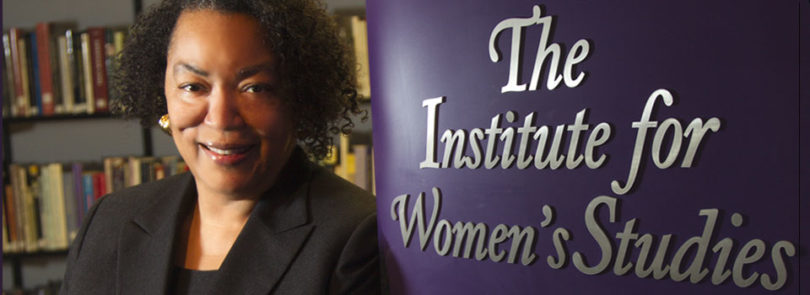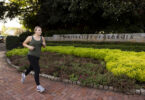Juanita Johnson-Bailey, director of UGA’s Institute for Women’s Studies, believes there is much to be explored on the subject of how gender and race impact education and learning.
Where did you earn degrees, and what are your current responsibilities at UGA?
Although I am a military brat, and I’ve been fortunate enough to see quite a bit of the world, I’m a Georgia girl through and through. I was born at Fort Benning, and most of my schooling has been in Georgia. I completed my doctoral studies at UGA in 1993 and returned here to teach in the fall of 1995.
As the director of the Institute for Women’s Studies, I work with the core faculty and staff of the institute to promote a feminist interdisciplinary perspective on women and gender through our coursework and outreach. Simply stated, this means recognizing the contributions of women in all aspects of society, past and present, as well as working for women’s empowerment. As I once told a gathering of Brownies, “I believe that girls and boys are equal and I try to make sure that others also know this.” While the institute is administratively part of the Franklin College of Arts and Sciences, our connections are university-wide.
When did you come to UGA, and what brought you here?
I was hired in 1995 as a joint faculty member by Women’s Studies and the department of adult education in the College of Education to help infuse diversity into their respective curricula. I’m very happy to say that the three courses that I developed, Multicultural Perspectives on Women in the U.S. (WMST 1110), Race and Gender in the Professions (EADU 8140), and Feminist Pedagogy (EADU 8180) are still popular offerings for both units. I’m very proud of the fact that to date over 5,000 undergraduates have completed WMST 1110.
What are your favorite courses, and why?
My favorite courses are Multicultural Perspectives on Women in the U.S. (WMST 1110) and the Seminar on Southern Africa (EADU 6000), a study-abroad offering. Both of these courses involve a kind of travel. In one, you venture into new ways of seeing and thinking about women and in the other, you journey to the other side of the world. In both, I routinely witness changes in students’ perspectives. I can actually see the light-bulb moments, when their thinking changes and they start to see the world in broader and more global terms. It’s very gratifying.
What interests you about your field?
It continues to fascinate me that my area of research, which examines how gender and race impacts education and learning, is so central to the academy, and yet so under-examined. Whether you are looking at how the women philosophers of ancient Greece are routinely excluded from the historical re-telling or how the popular media mis-educates the public about women, there is so much to be explored – and that means that the possibilities are limitless.
What are some highlights of your career at UGA?
The highlight of my career has been my 25 Ph.D. students. I feel that this is my legacy. And I’m still working on it.
How does your research or scholarship inspire your teaching?
There is a definitive and direct connection between my scholarship and my teaching. For example, my course, Gender, Media, and Mis-Education focused on the women in the 2008 presidential election. And at the same time I was completing a book chapter on how women learn and experience the workplace through mentoring. Luckily, my scholarship and my teaching have always been simpatico.
What are some of your publications?
My book Sistahs in College: Making a Way Out of No Way (2000) received the Phillip E. Frandson Award for Literature in Continuing Higher Education and the Sadie T. Mossell Alexander Award for Outstanding Scholarship in Black Women’s Studies. My most recent book is the Handbook of Race in Adult Education (2010). And probably my publication that is cited the most is a journal article that appeared in the Harvard Educational Review in 2008: Different worlds & Divergent paths: Academic Careers Defined by Race and Gender.
What do you hope students gain from their classroom experience with you?
I want students to see that we are living in a global community and that we have a commitment to be good citizens and lifelong learners in this expansive neighborhood. So I want be part of the process that helps them learn to think critically and to act responsibly by understanding that we are all connected.
Describe your ideal student.
My ideal student is the one who is engaged and eager to know more and more. This kind of student pushes the envelope in the classroom and it improves the collective experience. Being challenged is not the most comfortable circumstance in the class, but I find that it always makes for a better experience.
Favorite place to be/thing to do on campus … Proudest moment at UGA?
My favorite place and my proudest moment are the same: graduation. Whether I’m hooding or reading the names at graduation, it’s such a joy-filled moment. It’s my favorite place to be and my proudest moment. The students have such a sense of accomplishment and the happiness at graduation is almost overwhelming.
Beyond the UGA campus, I like to…
One of my favorite weekly pastimes is taking long walks by the river. And the other favorite, but occasional, pursuit is going to museums. I never visit a new place without checking out the museums in the area. Fortuitously, I travel quite a bit on university business and I always substitute a museum visit for a lunch or dinner.
Community/civic involvement includes….
Presently, I’m working with an initiative to help reentry women students be successful in their new schooling experience. This mentoring initiative involves meeting with the women as their non-academic mentor.
Favorite book/movie?
My favorite book is Revolution from Within by Gloria Steinem. I’m more of a theater buff than a movie person and my favorite Broadway play is Aida.







